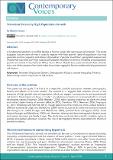Files in this item
Terrorism driven by high population growth
Item metadata
| dc.contributor.author | Coccia, Mario | |
| dc.date.accessioned | 2018-10-16T10:16:34Z | |
| dc.date.available | 2018-10-16T10:16:34Z | |
| dc.date.issued | 2018-05-03 | |
| dc.identifier.citation | Coccia, M., 2018. Terrorism Driven by High Population Growth. Contemporary Voices: St Andrews Journal of International Relations, 1(1), pp.1–13. DOI: http://doi.org/10.15664/jtr.1469 | en_US |
| dc.identifier.issn | 2516-3159 | en_US |
| dc.identifier.uri | https://hdl.handle.net/10023/16223 | |
| dc.description.abstract | A fundamental problem in conflict studies is how to explain the root causes of terrorism. This study suggests that terrorism thrives in specific regions with high growth rates of population that may generate income inequality and relative deprivation of people. In addition, geospatial analysis here reveals that countries with high association between fatalities for terrorist incidents and population growth are mainly in Sub-Saharan Africa, North Africa, Middle East, East and South Asia. Overall, then, one of the causes of terrorism is due to sociodemographic factors combined with psychosocial risk factors. | en_US |
| dc.language.iso | en | en_US |
| dc.publisher | School of International Relations, University of St Andrews | en_US |
| dc.relation.ispartof | Contemporary Voices: St Andrews Journal of International Relations | en_US |
| dc.rights | Copyright (c) the author. This is an open access article published in Contemporary Voices: St Andrews Journal of International Relations. This work is licensed under a Creative Commons Attribution 3.0 License (http://creativecommons.org/licenses/by/3.0/) | en_US |
| dc.rights | Attribution 4.0 International | * |
| dc.rights.uri | http://creativecommons.org/licenses/by/4.0/ | * |
| dc.subject | Terrorism | en_US |
| dc.subject | Population growth | en_US |
| dc.subject | Demographic factors | en_US |
| dc.subject | Income inequality | en_US |
| dc.subject | Poverty | en_US |
| dc.subject | Relative deprivation | en_US |
| dc.subject | Psychosocial risk factors | en_US |
| dc.subject.lcc | JZ | en_US |
| dc.subject.lcsh | International relations | en_US |
| dc.title | Terrorism driven by high population growth | en_US |
| dc.type | Journal article | en_US |
| dc.description.version | https://doi.org/Publisher PDF | en_US |
| dc.publicationstatus | Published | en_US |
| dc.status | Peer reviewed | en_US |
| dc.identifier.doi | https://doi.org/http://doi.org/10.15664/jtr.1469 | en |
The following licence files are associated with this item:
This item appears in the following Collection(s)
Except where otherwise noted within the work, this item's licence for re-use is described as Copyright (c) the author. This is an open access article published in Contemporary Voices: St Andrews Journal of International Relations. This work is licensed under a Creative Commons Attribution 3.0 License (http://creativecommons.org/licenses/by/3.0/)
Items in the St Andrews Research Repository are protected by copyright, with all rights reserved, unless otherwise indicated.


